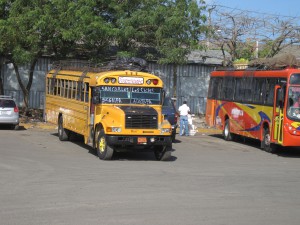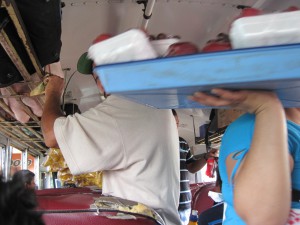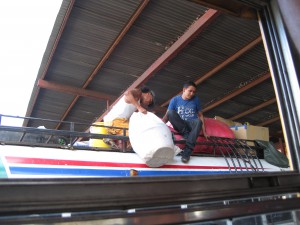Buzzing bus
Among all the possibilities one has to cover some distance on our planet, buses are way down my list of preferences, followed only by cars and airplanes. My personal opinion is that trains are the way to go for anything up to - and probably also beyond - 1000 km. Unfortunately most Nicaraguan train connections were shut down in 1993 and since 2001 there are no more trains at all in this country. Following my 1000 km rule, that clearly shuts out flying from Managua to San Carlos, we take the bus.
For larger distances one usually has the choice between an “expresso” bus and the so called “ruteado”, that basically just stops more often on its route. For some reason though, we were not able to find an “expresso” bus up to now.
 The bus we would take was an old school bus from North America and we
stuffed our back bags in the overhead compartments. Getting comfortable in
ones seat is hard for anyone a little taller than 175 cm, since seats are
fitted for local sized people. Loading the bus not only means getting all
the passengers on board, but also storing bulky luggage on the roof, that is
fitted with a huge rack to accommodate anything too small for a truck and
too big for the inside of the bus.
The bus we would take was an old school bus from North America and we
stuffed our back bags in the overhead compartments. Getting comfortable in
ones seat is hard for anyone a little taller than 175 cm, since seats are
fitted for local sized people. Loading the bus not only means getting all
the passengers on board, but also storing bulky luggage on the roof, that is
fitted with a huge rack to accommodate anything too small for a truck and
too big for the inside of the bus.
Prior to departure, lots of people wander through the bus, selling everything a traveler might want or need for the trip: all kinds of local food, fruits, juices, water, soft drinks, medicine, watches and all sorts of other stuff can be bought for a dollar or two.
 The bus leaves the station quite on time and
we are curious how the trip will unfold. While passing the busy streets
of Managua we frequently stop to pick up more passengers and more mobile
vendors. The peddlers will hop on and stay for a stop or two until
leaving the bus again. Moving through the bus gets more and more
complicated since all seats are taken and some passengers end up
standing in the aisle.
The bus leaves the station quite on time and
we are curious how the trip will unfold. While passing the busy streets
of Managua we frequently stop to pick up more passengers and more mobile
vendors. The peddlers will hop on and stay for a stop or two until
leaving the bus again. Moving through the bus gets more and more
complicated since all seats are taken and some passengers end up
standing in the aisle.
 Most North Americans refer to this kind of
transportation by the colorful name chicken bus. I am personally not
very fond of the name, but since it even has it’s own entry in
wikipedia it seems worth mentioning. Our bus even deserves the name
since one of the passengers actually carries two live chicken ( a hen
and a rooster). But the two animals seem to be seasoned travelers and
only occasionally confirm their presence by crowing and clucking
respectively.
Most North Americans refer to this kind of
transportation by the colorful name chicken bus. I am personally not
very fond of the name, but since it even has it’s own entry in
wikipedia it seems worth mentioning. Our bus even deserves the name
since one of the passengers actually carries two live chicken ( a hen
and a rooster). But the two animals seem to be seasoned travelers and
only occasionally confirm their presence by crowing and clucking
respectively.
Every once a while the bus get’s visited by people that are begging for money. Mostly they start by telling their life story with powerful eloquence, stressing why they are unable to make a living and ending by apologizing for any inconvenience they might cause the passengers. They also state that any contribution is absolutely voluntary and greatly appreciated. The stories people are telling vary in credibility, but when a one legged young man stumbles through the bus on crutches, there is no real need for further explanation.
While the bus moves south along the smooth highway, the landscape gradually changes from the dusty brown and gray around Managua to the more and more green rainforest colors. Every once a while the stench of burned plants reaches our noses and reminds of the slash-and-burn method to clean land for growing new produce. Other, even more unpleasant odors bear witness of dead animals, that provide food for the numerous vultures circling the skies.
The further away from the city, the more often we see people on horses and horses pulling carts. Not that horses and carts are totally unusual in Managua itself, but the horse to car ratio is definitely bigger in the country and nowhere in Managua have we seen a boy riding home from school on his horse.
In a certain sense we are not only traveling from Managua to San Carlos but also through time. It serves as a reminder that no too long ago cars were rare in our countries too, and horses were work tools and not prestigious pieces of sports equipment.